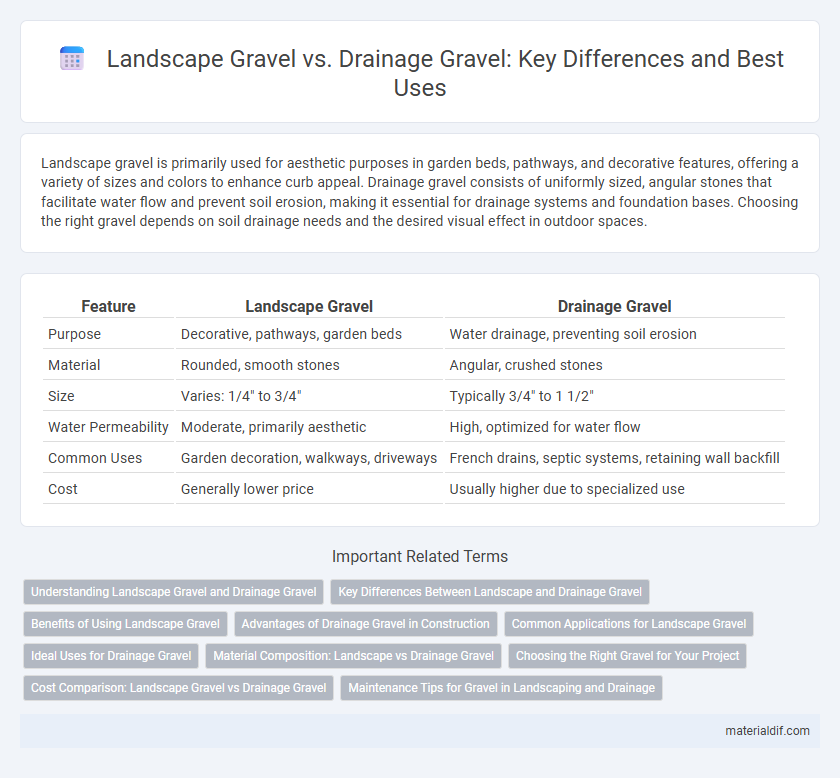Landscape gravel is primarily used for aesthetic purposes in garden beds, pathways, and decorative features, offering a variety of sizes and colors to enhance curb appeal. Drainage gravel consists of uniformly sized, angular stones that facilitate water flow and prevent soil erosion, making it essential for drainage systems and foundation bases. Choosing the right gravel depends on soil drainage needs and the desired visual effect in outdoor spaces.
Table of Comparison
| Feature | Landscape Gravel | Drainage Gravel |
|---|---|---|
| Purpose | Decorative, pathways, garden beds | Water drainage, preventing soil erosion |
| Material | Rounded, smooth stones | Angular, crushed stones |
| Size | Varies: 1/4" to 3/4" | Typically 3/4" to 1 1/2" |
| Water Permeability | Moderate, primarily aesthetic | High, optimized for water flow |
| Common Uses | Garden decoration, walkways, driveways | French drains, septic systems, retaining wall backfill |
| Cost | Generally lower price | Usually higher due to specialized use |
Understanding Landscape Gravel and Drainage Gravel
Landscape gravel primarily consists of small, decorative stones designed for aesthetic appeal in garden beds, pathways, and driveways, enhancing soil stability and preventing weed growth. Drainage gravel features larger, more angular rocks that facilitate water flow and prevent water accumulation, commonly used in French drains, retaining walls, and foundation beds. Understanding the differences in size, shape, and purpose helps select the appropriate type of gravel for effective landscaping and drainage solutions.
Key Differences Between Landscape and Drainage Gravel
Landscape gravel is primarily designed for aesthetic purposes, featuring smooth, rounded stones that enhance garden paths, patios, and decorative borders. Drainage gravel consists of angular, crushed stones that facilitate water flow and prevent soil erosion in drainage systems and French drains. The key difference lies in texture and function: landscape gravel prioritizes visual appeal, while drainage gravel is engineered for effective water management and structural support.
Benefits of Using Landscape Gravel
Landscape gravel enhances outdoor aesthetics by providing a visually appealing ground cover that reduces soil erosion and suppresses weed growth. It improves water drainage around plants and walkways while offering a durable, low-maintenance solution suitable for gardens, driveways, and pathways. Using landscape gravel also promotes soil aeration, supports healthy root systems, and increases property value with its versatile and natural appearance.
Advantages of Drainage Gravel in Construction
Drainage gravel offers superior water flow and prevents soil erosion, making it invaluable in construction projects that require stable foundations and effective water management. Its angular shape and larger particle size create voids that facilitate drainage, reducing the risk of water accumulation and foundation damage. Utilizing drainage gravel enhances structural integrity and longevity by maintaining proper moisture levels around building foundations and retaining walls.
Common Applications for Landscape Gravel
Landscape gravel is commonly used for decorative pathways, garden beds, and driveways due to its aesthetic appeal and variety of colors and sizes. It helps with weed control and soil erosion prevention while enhancing outdoor living spaces. Unlike drainage gravel, which is primarily selected for water flow and drainage systems, landscape gravel focuses more on visual enhancement and surface stability.
Ideal Uses for Drainage Gravel
Drainage gravel is specifically designed with larger, angular stones that create void spaces to facilitate water flow and prevent soil erosion, making it ideal for applications such as French drains, septic systems, and foundation drainage. Unlike landscape gravel, which is primarily decorative and used for pathways or garden beds, drainage gravel's permeability ensures efficient water movement and reduces water pooling around structures. Its composition typically includes crushed stone sizes ranging from 3/4 inch to 1 1/2 inches, optimized to enhance soil drainage and stability.
Material Composition: Landscape vs Drainage Gravel
Landscape gravel typically consists of smooth, rounded stones such as river rock or pea gravel, designed for aesthetic appeal and comfortable walking surfaces in gardens and pathways. Drainage gravel is composed of angular, crushed stones like limestone or granite, which create larger gaps for efficient water flow and prevent soil erosion in drainage systems. The material composition difference directly impacts functionality, with landscape gravel prioritizing appearance and drainage gravel emphasizing permeability.
Choosing the Right Gravel for Your Project
Landscape gravel is primarily used for aesthetic purposes, providing ground cover and enhancing garden paths with a variety of colors and sizes, while drainage gravel features larger, uniformly sized stones designed to facilitate water flow and prevent soil erosion. Selecting the right gravel depends on your project's goal: opt for landscape gravel to improve curb appeal and comfort, or drainage gravel for applications requiring efficient water management, such as French drains or septic fields. Consider the gravel's composition, size, and porosity to ensure durability and functionality tailored to specific landscaping or drainage needs.
Cost Comparison: Landscape Gravel vs Drainage Gravel
Landscape gravel typically costs between $30 and $50 per ton, while drainage gravel ranges from $40 to $60 per ton due to its specialized composition and functionality. The higher cost of drainage gravel reflects its optimized size and shape designed for effective water flow and soil stability, making it essential for drainage systems. Choosing landscape gravel for aesthetic purposes can reduce upfront expenses, but drainage gravel ensures long-term structural benefits, influencing overall project cost-effectiveness.
Maintenance Tips for Gravel in Landscaping and Drainage
Landscape gravel requires regular raking and occasional replenishment to maintain an even surface and prevent weed growth, while drainage gravel benefits from periodic flushing to avoid clogging and ensure optimal water flow. Installing a proper weed barrier beneath landscape gravel reduces maintenance time and enhances longevity. For drainage gravel, inspecting and clearing debris from surrounding areas minimizes blockages, promoting effective drainage functionality.
Landscape Gravel vs Drainage Gravel Infographic

 materialdif.com
materialdif.com